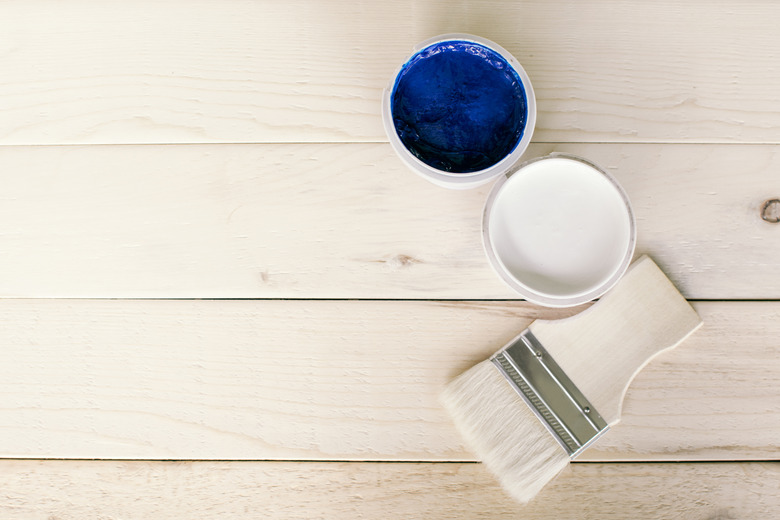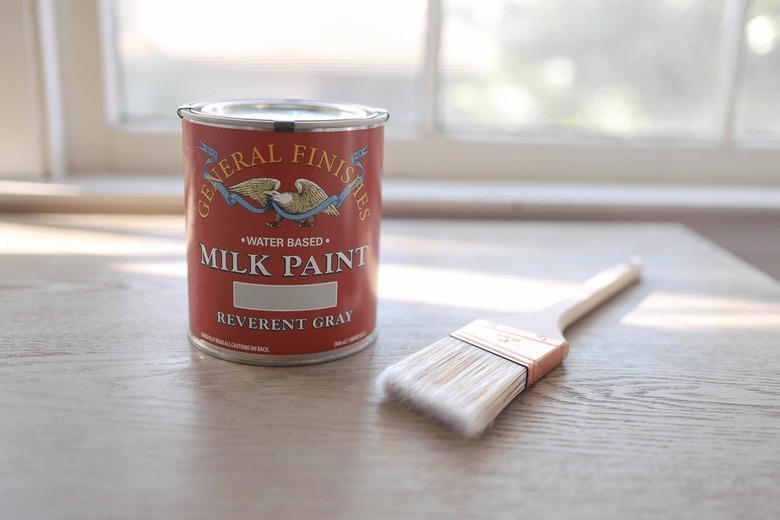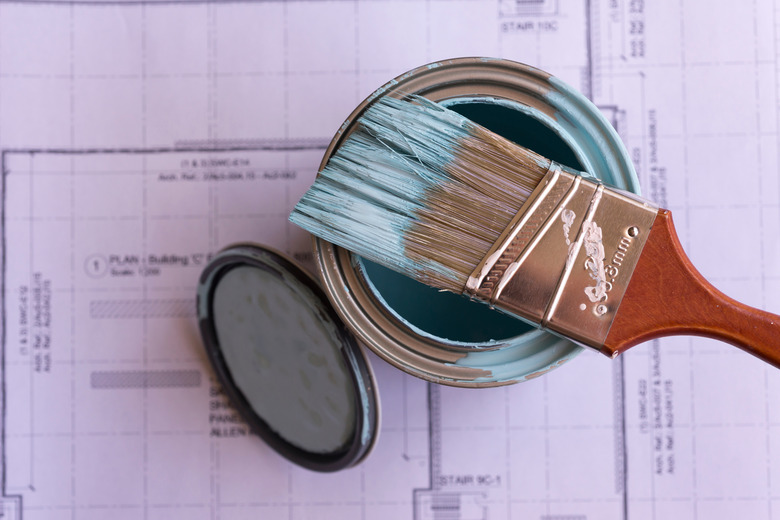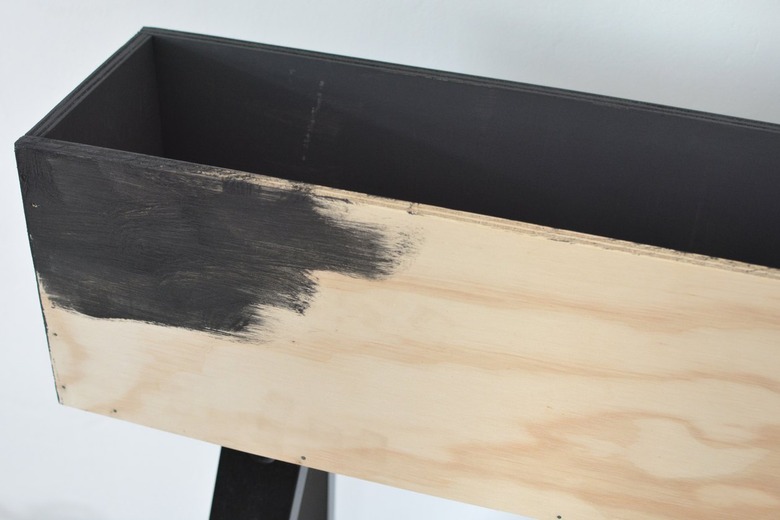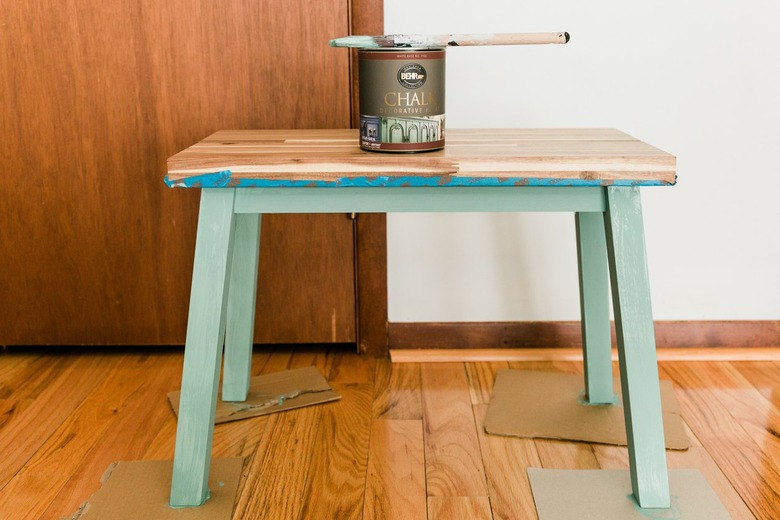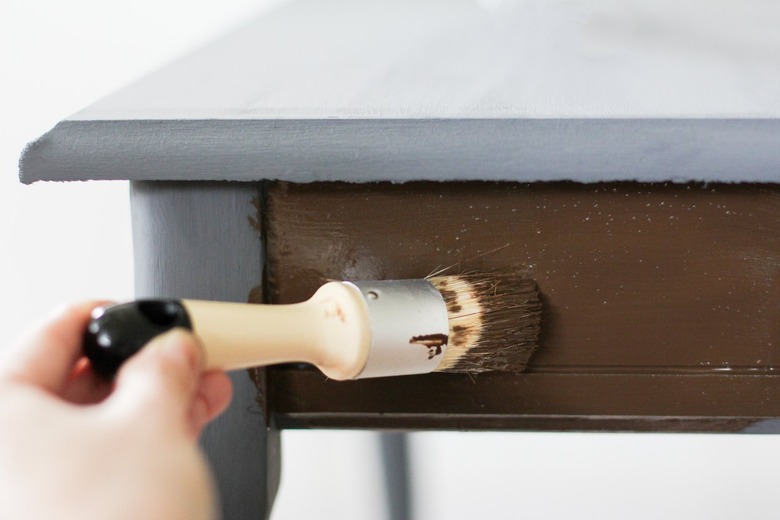Milk Paint Vs. Chalk Paint — Which Should I Use?
We may receive a commission on purchases made from links.
Does the paint section of your favorite home improvement store leave you feeling overwhelmed? Latex vs. oil paint, milk paint vs. chalk paint — figuring out the differences and the best uses for each one can take longer than the painting project itself. When you're looking for a farmhouse or vintage look, both milk paint and chalk paint are good alternatives to traditional paint. If you've narrowed your options to these two varieties of low-VOC paint, comparing the differences can help you decide which is better for your project.
What Is Milk Paint?
What Is Milk Paint?
Milk paint is an environmentally friendly, nontoxic paint formulation that creates beautiful finishes on painted projects. It contains milk protein, or casein, along with other natural ingredients, such as clay and lime, creating a no-VOC paint without the strong odors you're used to when you pick up a paintbrush. It typically comes as a powder that you mix with water when you're ready to paint.
What Is Chalk Paint?
What Is Chalk Paint?
Annie Sloan is the designer behind chalk paint, which shouldn't be confused with chalkboard paint — a product that turns surfaces into chalkboards. Sloan invented chalk paint because she was frustrated by the paint options for furniture available in the 1990s. Chalk paint is a low-VOC paint consisting of calcium carbonate (which gives it its signature chalky finish), talc, acrylic binders, and pigments. Like milk paint, chalk paint works well on a variety of surfaces, including wood, metal, glass, brick, and plaster.
Milk Paint vs. Chalk Paint — Key Differences
Milk Paint vs. Chalk Paint — Key Differences
Since both products are environmentally friendly options, it's common for people to find themselves comparing milk paint vs. chalk paint. They both work well for vintage, distressed, and farmhouse-style finishes and both types of paint give a matte finish instead of a shiny one. Using either of them to paint furniture is a popular DIY project.
Despite the similarities, you'll notice some subtle differences between milk and chalk paints. Those differences can often help you decide which type of paint is right for your various DIY makeover projects.
Milk Paint
- Thin consistency
- Pigment comes in powder form
- Requires DIY mixing with water
- Adheres to most clean, dry surfaces and requires minimal surface prep
- Allows for unlimited custom color options
- Organic, no VOCs, and nontoxic
- Powder can be stored indefinitely
- Short shelf life once mixed
- Matte finish with a slight sheen
- May leave visible brush strokes
- Can have smooth or distressed finish
Chalk Paint
- Thick consistency
- Comes pre-mixed
- Adheres to most clean, dry surfaces and requires minimal surface prep
- Comes in a variety of colors
- No custom paint color options
- Inorganic, low-VOC, often nontoxic
- Can be stored for 1-5 years
- Matte, chalky finish
- Leaves no visible brush strokes
- Can have smooth or distressed finish
Consistency of Chalk Paint vs. Milk Paint
You'll notice a difference in the consistency of milk paint vs. chalk paint. Milk paint has a thinner consistency than chalk paint and other types of paint. This thinner consistency lets the natural texture of the piece show through and can help create the distressed look you want. Thicker chalk paint can also help cover the texture of whatever you're painting for a smoother finished look.
Milk paint can be a bit lumpy if you're mixing it yourself from powder. Mixing it in an older blender or with the mixing attachment on a drill can give you smoother results without the lumps. Chalk paint is often available premixed so you can avoid the lumpiness.
Prep
A major difference is how you prepare each type of paint. You'll usually buy milk paint in a powder form, which you mix with water when you're ready to paint. The freshly mixed paint needs 10 to 30 minutes to settle and for the pigments to dissolve before using it. Chalk paint is ready to go in the container. It just needs to be mixed a little to redistribute the pigments.
As far as preparing the surface you want to paint, neither milk paint nor chalk paint requires sanding or priming in most cases. The paint sticks to most clean, dry surfaces without much prep work. However, you can go over the surface with sandpaper to improve adhesion. This can be especially helpful if you're using milk paint, which usually sticks a little better with sanding.
Paint Color Options
You can get a variety of paint colors for both types, but milk paint can give you more options. That's because you can mix different paint powders to create custom blends. If you experiment with custom colors on a small scale, keep track of the ratios you used make it easier to recreate in the future.
With chalk paint, you're typically limited to the available colors. You can't really mix two different colors to get a new color. This means the color palette is typically more limited with chalk paint.
Chalk Paint vs. Milk Paint Toxicity and Eco-Friendliness
Both types are generally better for you and the environment than latex paint (conventional water-based paint), which is toxic, although there are low-VOC and no-VOC formulas available. Milk paint is made from organic materials, has no VOCs, and is nontoxic. However, if you add binders or other additives, you could introduce toxic ingredients or VOCs into the mix. Choose your additives carefully if you want to keep the paint free of VOCs.
Chalk paint has some VOCs, but it's still considered low-VOC paint. It contains inorganic ingredients, and not all brands are nontoxic, although some are. While both options are good alternatives to conventional paint, milk paint typically has a slight edge in this area.
Paint Storage Methods
Milk paint typically comes in powder form, which allows you to store it for longer periods. Some premixed versions are available, but they typically have a bonding agent added, which eliminates the natural chipping of traditional milk paint. Keep the powder dry and in a sealed, airtight container so it lasts indefinitely. Air and moisture can activate the lime in the powder, causing it to become chalky, which prevents it from mixing and adhering properly.
Finished Look of Chalk Paint vs. Milk Paint
Both types of paint have a fairly matte look when dry, although milk paint does have a slight sheen to it. Chalk paint has a more chalky look with a smooth texture. If you don't apply a protective coating, chalk paint will naturally distress more as time passes, especially on surfaces that get used frequently. It's also susceptible to stains and damage if it's not protected.
Tip
Chalk paint typically doesn't leave any visible brushstrokes on your finished product. If you want the look of brushstrokes to be visible, milk paint is a better choice.
Milk paint can create a smooth finish as well if you apply it to raw, porous wood or add a bonding agent. Applying milk paint to previously finished pieces without sanding them typically creates chips and flakes where the paint resists certain areas. You can also apply wax and products designed to create the chippy look in random spots on the piece; the milk paint will resist those areas and chip away as it dries. Milk paint can also become more distressed with age.
How to Use Milk Paint
How to Use Milk Paint
When using milk paint on furniture or other surfaces, you'll want to follow specific steps for best results:
- Prepare the surface you plan to paint. Once you mix the paint, you should start painting quickly. For most items, that means cleaning the surface. However, sanding the surface gently can also help milk paint adhere.
- Measure the amount of milk paint you want to mix. Since it doesn't last long once it's prepared, mix only the amount you need.
- Add an equal amount of water or the amount indicated in the package instructions.
- Add a bonding agent if you want a more uniform finish without the natural distressing that happens with milk paint.
- Mix the powder and water by hand, in a blender, or with a mixer attachment.
- Wait for 10 to 30 minutes after mixing.
- Paint the surface with the first coat. Wait until it dries — usually in under an hour — before applying additional coats.
- Apply more coats, waiting for the paint to dry between each until you get the look you want.
- Apply the wax or oil if you're using it as a protective coat.
How to Use Chalk Paint
How to Use Chalk Paint
Chalk paint uses a similar process to milk paint, but it comes ready to use, which means you can skip the paint mixing steps.
- Prep the surface you want to paint by cleaning it. Chalk paint doesn't need any sanding or priming.
- Stir the premixed chalk paint to redistribute the pigments.
- Apply your first coat of chalk paint to the surface. Let it dry for about one to three hours until it's completely dry.
- Apply another coat. Since chalk paint is thicker than milk paint, you usually only need two coats. Let it dry completely
- Finish the piece with a wax coating if you're using it. Use lint-free cloths to wipe the wax over the surface.
Protective Topcoat Options
Protective Topcoat Options
Once you get your furniture painted with chalk paint or milk paint, you can protect it with a sealer or topcoat. Both types of paint almost always need to be protected unless it's a surface that doesn't get touched often, such as home decor that you display. Even then, a coating is recommended if you want to retain the color and avoid additional distressing.
Clear wax coatings are popular options. The wax helps create a deeper color, and it protects the painted piece from stains, fingerprints, water, and additional distressing. You can also use dark wax to emphasize the distressing and other unique qualities of the piece. Chalk paint typically needs more coats of wax than milk paint to get enough protection to prevent damage.
You can also use finishing oils as a protectant for milk paint. Two common options are hemp oil and tung oil. For chalk paint, an alternative to using wax is varnish or lacquer.
Use Milk Paint For...
- Distressed or chipped finishes (read: shabby chic)
- Visible brushstrokes
- Capturing the natural texture of the piece
- Creating custom colors
Use Chalk Paint For...
- Smooth finishes
- Fewer coats of paint
- Convenience (no measuring or mixing)
- Covering old layers of paint or finish without prep work
